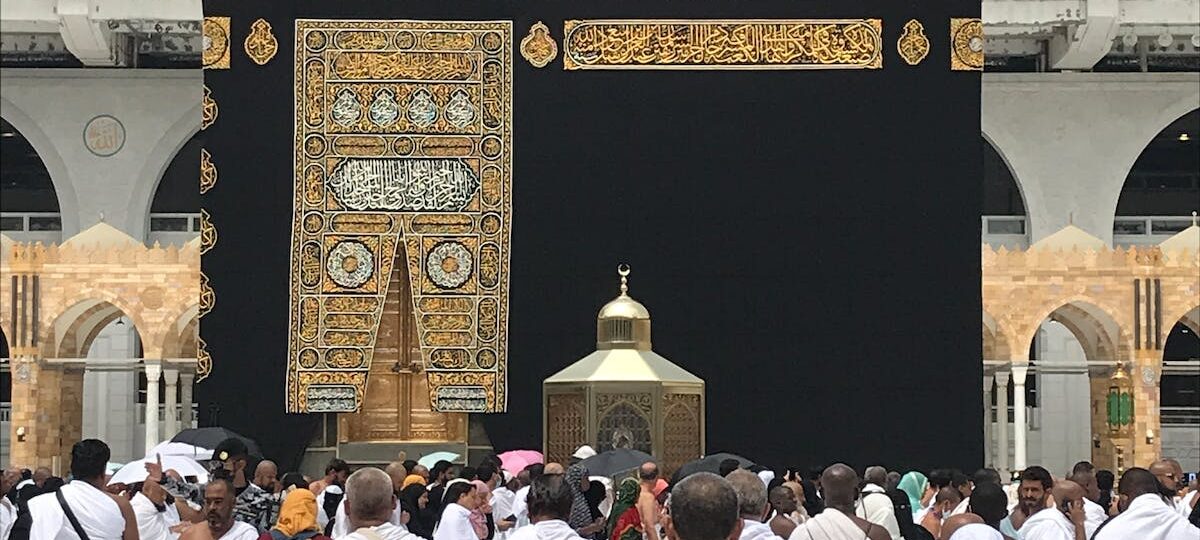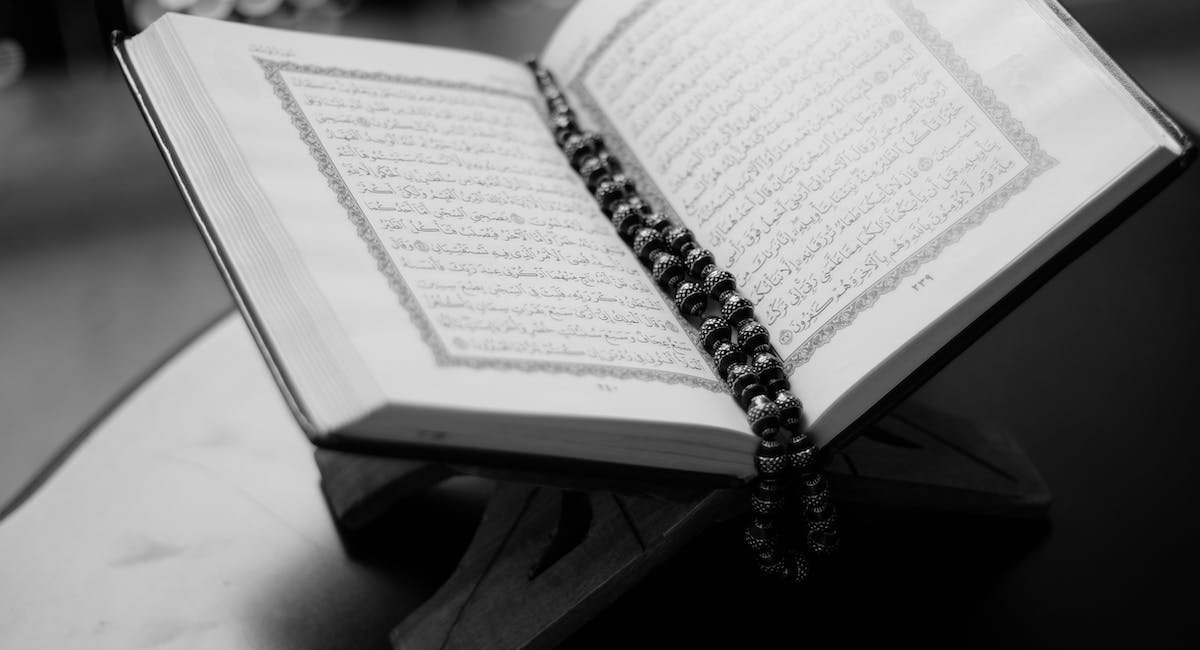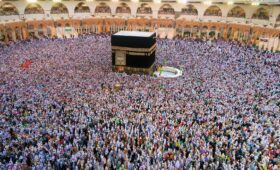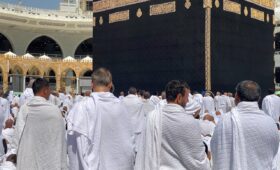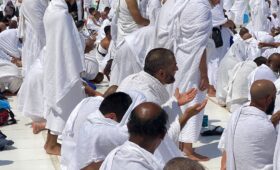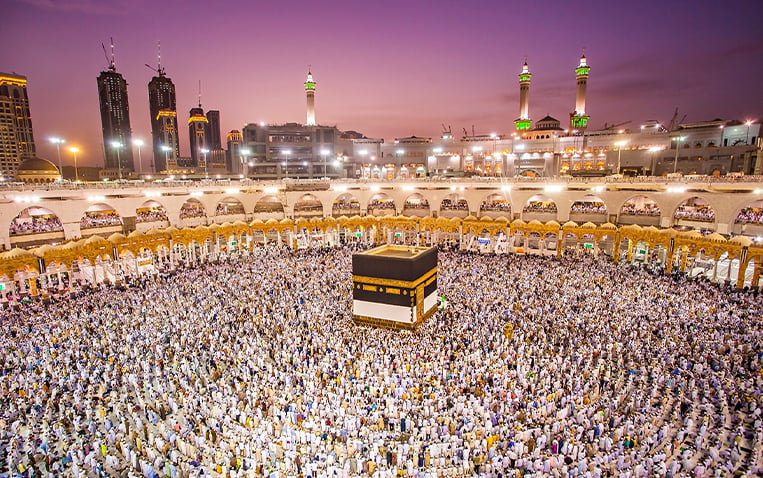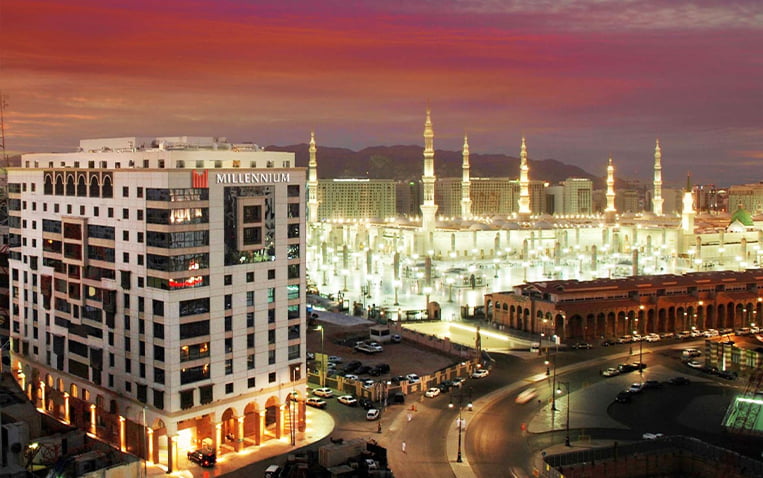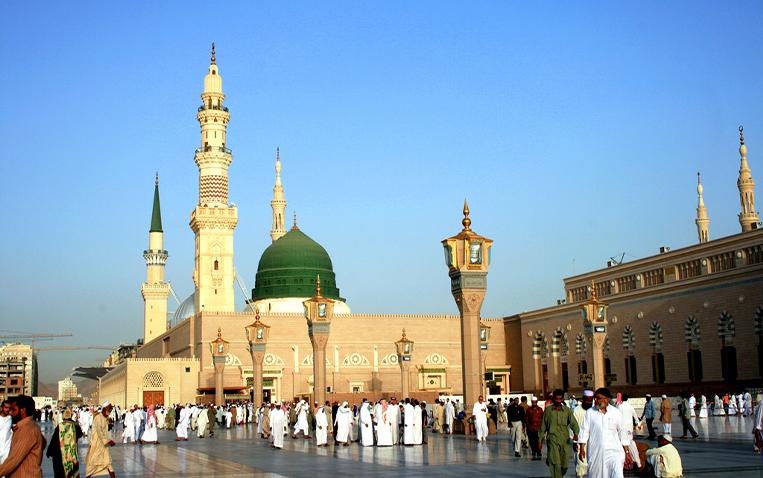Khana-e-Kaaba, occupies a central and meaningful role in Islamic spirituality. Situated within Makkah Masjid Al-Haram mosque in Saudi Arabia, its symbolic religious meaning for Muslims worldwide cannot be understated. According to Islamic tradition, its construction by Ibrahim and Ismail as their first house dedicated to worship of one true Allah has come full circle: its Black Stone a sacred meteorite embedded into one corner makes this focal point for both annual pilgrimage (Hajj), as well as lesser pilgrimages (Umrah).
The Khana-e-Kaaba is located within Masjid al-Haram in Makkah, Saudi Arabia and it is one of Islam’s most revered mosques and holy sites. Covered by silk and cotton fabric veils, it serves as the centerpiece for Muslim religion and pilgrimages such as Hajj and Umrah pilgrimages as their final stop before departing Makkah on holy pilgrimages such as Hajj and Umrah pilgrimages its history goes back before Islam was established there.
One fascinating element of Islamic belief is its status as the Kaaba center of the Earth. This notion stems from its status as Allah’s House in Makkah, marking its significance for Muslims worldwide. Though physically located there, spiritual significance of the Kaaba can still be felt around the globe through daily prayers (Salah), where Muslims worship while facing Makkah as they face towards it during worship acts this symbolic connection further highlights its unique role as unifier within Islam.
Other Names of The Khana-e-Kaaba
The Kaaba is located at the Masjid al-Haram in Makkah and has several names which reflect its significance within Islamic tradition. One popular alternative name for it is “House of Allah,” or Baytullah in Arabic; this refers to Muslims worldwide believing it as Allah’s house holds immense spiritual importance for them worldwide. Another commonly used title for it is “Sacred House,” or Al-Bayt al-Haram in Arabic, emphasizing its reverence within Islamic belief systems.
Similarly, the Kaaba is commonly referred to as the “House of God” or “Baytu Allahi al-Haram,” reflecting its central role as an anchor during prayers and pilgrimage rituals for Muslims worldwide. Furthermore, its various names reflect its deep spiritual and historical significance within Islam’s tradition as an symbolic center for unity, devotion and worship for Muslims worldwide.
The History and form of Khan-e-Kaaba
Hajj is something every Muslim aspires to experience at least once in their lifetime, as part of Islam’s fifth pillar: Hajj (which means “cube” in Arabic) stands 15 meters high with black silk covering its cube-shaped structure; long before Islam there existed a shrine on that peak where Khan-e-Kaaba now stands; its construction can be traced back to Prophet Ibrahim and Ismail from Islamic history.
Around 608 C.E, the Quraysh tribe that ruled Makkah rebuilt the pre-Islamic Kaaba with alternating layers of stone and wood to keep out outsiders and floodwaters; an aboveground door was added for access. Within this pre-Islamic Kaaba were statues representing divinities as well as statues depicting Allah; they included Black Stone which Muslims seek to touch or kiss during Hajj and Umrah pilgrimages.
After being exiled from Makkah in 620, Prophet Muhammad went back to Yathrib (now Madinah). Between 629 and 630 he returned, and Makkah’s shrine once more became the focal point for Muslim prayer and pilgrimage. On his successful return he is believed to have rid it of any idolatry within its confines to restore Prophet Ibrahim’s original beliefs for it as its true spiritual home.
Muslims adore the Black Stone, which the angel Gabriel is said to have given to Prophet Ibrahim. The Prophet Muhammad set up the pilgrimage rites during his last journey, which he made in 632, the year of his death.
Allah has mentioned the word Kaaba twice in the Quran and it is mentioned in two following verse:
يَا أَيُّهَا الَّذِينَ آمَنُوا لَا تَقْتُلُوا الصَّيْدَ وَأَنتُمْ حُرُمٌ ۚ وَمَن قَتَلَهُ مِنكُم مُّتَعَمِّدًا فَجَزَاءٌ مِّثْلُ مَا قَتَلَ مِنَ النَّعَمِ يَحْكُمُ بِهِ ذَوَا عَدْلٍ مِّنكُمْ هَدْيًا بَالِغَ الْكَعْبَةِ أَوْ كَفَّارَةٌ طَعَامُ مَسَاكِينَ أَوْ عَدْلُ ذَٰلِكَ صِيَامًا لِّيَذُوقَ وَبَالَ أَمْرِهِ ۗ عَفَا اللَّـهُ عَمَّا سَلَفَ ۚ وَمَنْ عَادَ فَيَنتَقِمُ اللَّـهُ مِنْهُ ۗ وَاللَّـهُ عَزِيزٌ ذُو انتِقَامٍ ﴿95﴾
O you who have faith! Do not kill any game when you are in pilgrim sanctity. Should any of you kill it intentionally, its atonement, the counterpart from cattle of what he has killed, as judged by two fair men among you, will be an offering brought to the Ka‘bah, or an atonement by feeding needy persons, or its equivalent in fasting, that he may taste the untoward consequences of his conduct. Allah has excused what is already past; but should anyone resume, Allah shall take vengeance on him, for Allah is all-mighty, avenger.
Allah provides guidance in this verse regarding one of the rules of hajj. If hunting animals occurs during hajj, atonement must take place either through making an offering (i.e. animal sacrifice) to Kaaba or feeding needy people or fasting.
The second Verse is the following:
جَعَلَ اللَّـهُ الْكَعْبَةَ الْبَيْتَ الْحَرَامَ قِيَامًا لِّلنَّاسِ وَالشَّهْرَ الْحَرَامَ وَالْهَدْيَ وَالْقَلَائِدَ ۚ ذَٰلِكَ لِتَعْلَمُوا أَنَّ اللَّـهَ يَعْلَمُ مَا فِي السَّمَاوَاتِ وَمَا فِي الْأَرْضِ وَأَنَّ اللَّـهَ بِكُلِّ شَيْءٍ عَلِيمٌ ﴿97﴾
Allah has made the Ka‘bah, the Sacred House, a [means of] sustentation for mankind, and [also] the sacred month, the offering and the garlands, so that you may know that Allah knows whatever there is in the heavens and whatever there is in the earth, and that Allah has knowledge of all things.
Indeed, our narrations indicate that the earth began as one large expanse of land and then the Kaaba was built upon it. From there the earth spread outward and all continents and lands formed – giving Mecca its nickname Mother of Cities. The event of spreading occurred on Dhul Qa’dah 25 in Arabic language known as Dahw al-Ard.
Modifications on Khana-e-Kaaba
The Khana-e-Kaaba, often referred to as “Allah’s House,” stands as Islam’s holiest site and can be found at Makkah Masjid al-Haram mosque in Saudi Arabia. According to Islamic tradition, its construction began with Prophet Ibrahim and Ismail as a sacred haven dedicated to worship of Allah Almighty this cubic structure draped with black silk and gold fabric known as Kiswa symbolizes its spiritual center role while the Black Stone embedded at one corner further amplifies its significance while Muslims face towards it during daily prayers, emphasizing its central position within Islamic worship.
Modifications have long been made to Allah’s house to ensure its longevity and accommodate an ever-increasing pilgrimage. Islamic caliphates such as Umayyads and Abbasids helped renovate, while the Ottoman Empire implemented measures to safeguard it against natural elements such as flooding. More recently, the Saudi government initiated numerous expansion projects in Masjid al-Haram to accommodate millions who come annually for Hajj and Umrah pilgrimages; these modifications aim to protect and uphold Allah’s house while creating more comfortable worshiping environments.
Allah’s house represents more than physical presence; it symbolizes unity and spiritual connection for Muslims worldwide. Annual replacement of Kiswas with verses from Quran indicates our reverence and care bestowed upon this sacred structure, while regular maintenance activities including gilding and repairs emphasize our dedication to safeguarding Allah’s house as a symbol of devotion, unwavering faith, unity, and reverence within Islamic tradition.
Since Allah’s house stands as an iconic symbol of spirituality and unity in Islamic faith, ongoing modifications include both historical renovations and contemporary expansion projects as well as ongoing preservation efforts to maintain its structural integrity and aesthetic grandeur.
Skilled craftsmen work diligently at tasks such as gilding to ensure the exterior radiates divine beauty while Kiswas handwoven by skilled craftspeople with verses from Quran are replaced annually during Hajj season to symbolize an everlasting commitment to reverence. All these modifications, whether designed to address practical needs or honor its enduring significance collectively contribute to keeping Allah’s house as an iconic symbol.
The Khana-e-Kaaba Today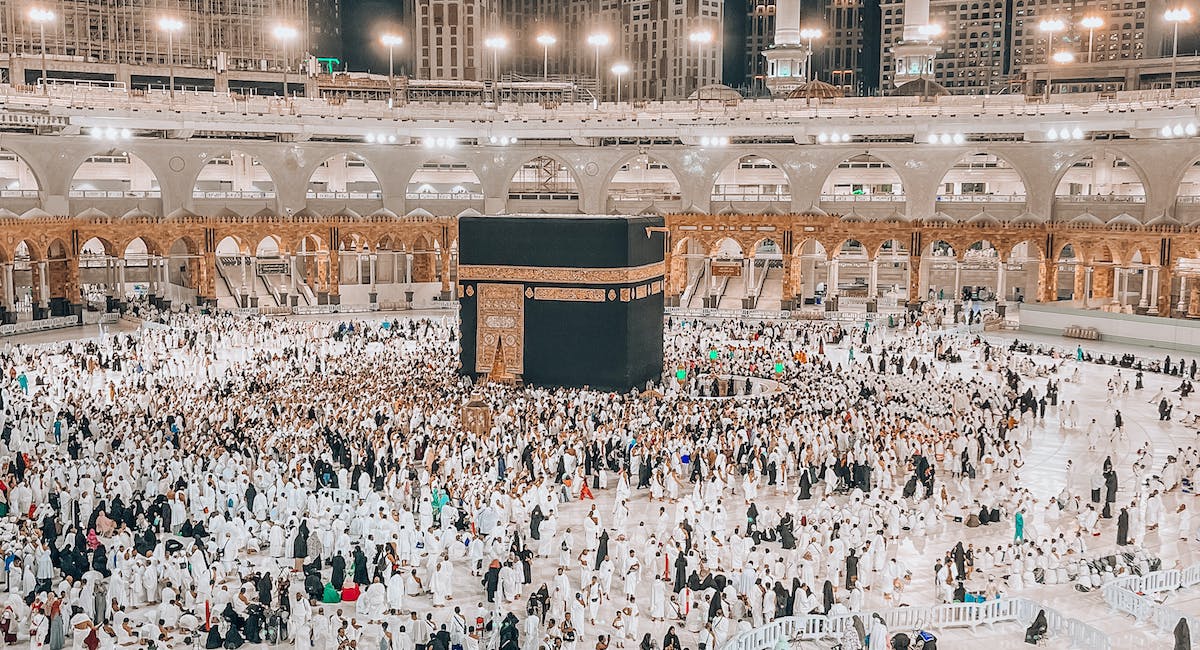
Today, the Kaaba continues to hold immense spiritual significance for Muslims around the world, drawing millions to Makkah each year for worship and prayers. Positioned as the spiritual nucleus of Islamic life, many view the Kaaba as the center of Earth; although geographically inaccurate this term holds immense religious and symbolic weight; facing towards it during daily prayers emphasizes its symbolic connection and brings about unity across distance.
Modern times sees the Kaaba as an epicenter for various acts of worship, especially during annual pilgrimages such as Hajj and Umrah. Modernization efforts and expansive projects surrounding Masjid al-Haram ensure that it can accommodate ever increasing pilgrim numbers; modern infrastructure such as crowd management systems provide worshipers with an efficient experience while upholding Allah’s House sanctity.
Tawaf, or circumambulating the Kaaba, remains an expression of devotion for Muslims worldwide. With its exquisite decoration and revered Black Stone, the Kaaba inspires both awe and respect from Muslim devotees around the globe its significance transcending physical structure into representing core Islamic belief and unifying diverse Muslim communities around the globe.
History of Khana-e-Kaaba Black Stone
The Black Stone (Al-Hajar Al-Aswad in Arabic), is revered in Islamic tradition as an extraordinary and celestial gem that was given to Prophet Ibrahim and Isma’il by Archangel Gabriel during their construction of the Kaaba. This meteorite can still be found today embedded into its southeast corner and its worship by pagan Arabs predating Islamic religion itself.
Through the centuries, pilgrims have worshiped the Black Stone during pilgrimage rituals of Hajj and Umrah pilgrimages. Pilgrims strive to touch or kiss it during Tawaf (circumambulation of Kaaba), mimicking Prophet Muhammad’s actions during his pilgrimage. Many also consider its connection with Prophet Ibrahim a source of added reverence; legend claims it once used to be pure white but turned black due to our collective sins.
Although revered, the Black Stone has endured historical difficulties that threaten its sacredness, including theft and damage. In 930 CE it was stolen and taken to an isolated location in present-day Iran before eventually returning home in 940 CE. Since then it has undergone repairs and preservation efforts, including replacement of damaged fragments. Today it stands as a symbol of devotion connecting present-day Muslims to ancient Islamic sacred traditions passed on from generation to generation.
What is inside the Khana-e-Kaaba?
The interior of one of Islam’s holiest sites, the Kaaba, remains largely hidden to the general public. Comprised of black silk and gold curtain covering, its cuboid structure features Quranic verses and calligraphy with no permanent fixtures or furniture in its interior space, pilgrims who have visited describe its serene spiritual atmosphere as free from any form of decoration; all Muslims stand equal before Allah regardless of any differences among us.
At its annual cleaning ceremony, the Kaaba’s interior walls are washed and perfumed before its black silk and gold cloth covering is replaced by a new kiswah (a black silk and gold cloth covering made of black silk and gold threads). Only twice annually does its door of gold open to allow pilgrims to perform Hajj or Umrah ceremonies where pilgrims walk around its perimeter while offering prayers towards it, understanding it to be at the spiritual core of Islam’s worldview. Furthermore, its simple interior serves as an effective reminder of Islam’s emphasis on humility, equality, and universal worship as part of its core values embodied within religion itself.
Who Built the Khana-e-Kaaba?
Though Allah doesn’t specifically name any individual as having been responsible for building the Kaaba, Islamic narrations generally acknowledge Prophet Adam (peace be upon him) was among those to initially create God’s dwelling place on Earth – known as Kaaba in Arabic. According to Islamic texts: Allah says in Quran:
إِنَّ أَوَّلَ بَيْتٍ وُضِعَ لِلنَّاسِ لَلَّذِي بِبَكَّةَ مُبَارَكًا وَهُدًى لِّلْعَالَمِينَ ﴿96﴾
Indeed the first house to be set up for mankind is the one at Bakkah, blessed and a guidance for all nations.
First off, Bakkah is simply another name for Makkah and secondly this verse indicates it as the very first house humans ever constructed Adam being the original human who built the Kaaba. Unfortunately it suffered damage during Noah’s great flood; hence repairs would likely need to be undertaken and rebuilt afterwards.
Who rebuilds the Khana-e-Kaaba?
Prophet Ibrahim, who lived some time after Prophet Noah, was a powerful prophet of Allah Almighty. Ibrahim is the next great prophet that we know of, following Noah. Rebuilding the Kaaba with the assistance of his older son, Prophet Ismail, was one of the great tasks that Allah assigned to this noble prophet. In the Quran, Allah says the following:
وَإِذْ بَوَّأْنَا لِإِبْرَاهِيمَ مَكَانَ الْبَيْتِ أَن لَّا تُشْرِكْ بِي شَيْئًا وَطَهِّرْ بَيْتِيَ لِلطَّائِفِينَ وَالْقَائِمِينَ وَالرُّكَّعِ السُّجُودِ ﴿26﴾
When We settled for Abraham the site of the House [saying], Do not ascribe any partners to Me, and purify My House for those who circle around it, and those who stand [in it for prayer], and those who bow and prostrate themselves.
وَإِذْ يَرْفَعُ إِبْرَاهِيمُ الْقَوَاعِدَ مِنَ الْبَيْتِ وَإِسْمَاعِيلُ رَبَّنَا تَقَبَّلْ مِنَّا ۖ إِنَّكَ أَنتَ السَّمِيعُ الْعَلِيمُ ﴿127﴾
As Abraham raised the foundations of the House with Ishmael, [they prayed]: ‘Our Lord, accept it from us! Indeed You are the All-hearing, the All-knowing.
رَبَّنَا وَاجْعَلْنَا مُسْلِمَيْنِ لَكَ وَمِن ذُرِّيَّتِنَا أُمَّةً مُّسْلِمَةً لَّكَ وَأَرِنَا مَنَاسِكَنَا وَتُبْ عَلَيْنَا ۖ إِنَّكَ أَنتَ التَّوَّابُ الرَّحِيمُ ﴿128﴾
‘Our Lord, make us submissive to You, and [raise] from our progeny a nation submissive to You, and show us our rites [of worship], and turn to us clemently. Indeed You are the All-clement, the All-merciful.
The Qibla of Muslims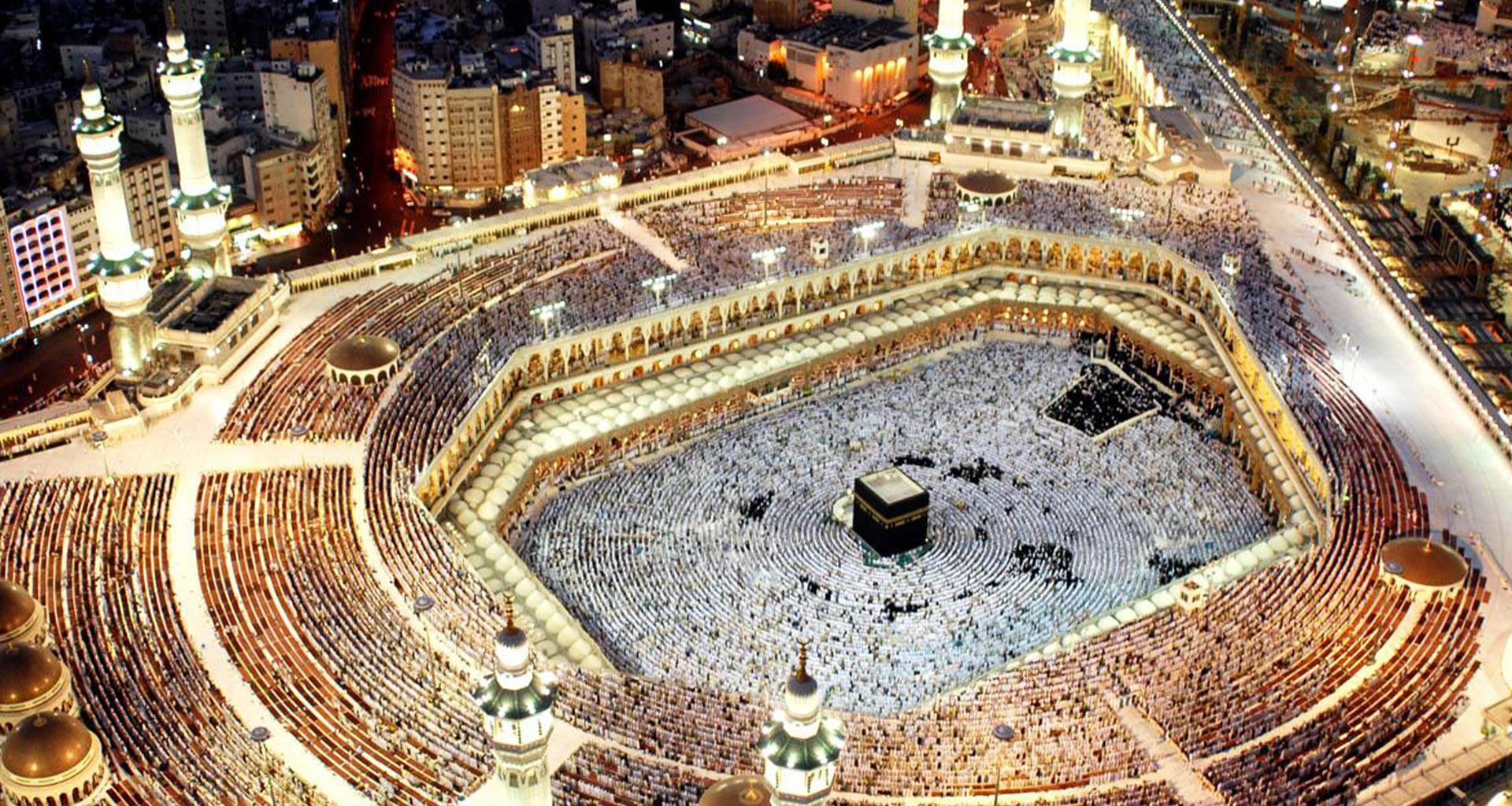
Masjid al-Aqsa was initially worshiped as the center of Muslim worship during the Prophet’s lifetime, rather than the Kaaba. While praying in Medina in what came to be known as Masjid Dhu Qiblatain (mosque with two qiblas). Allah changed the course of worship.
Historians believe that when Muhammad could, he would pray in the direction of Kaaba and Masjid al-Aqsa. When entering Mecca during their conquest of Makkah with Imam Ali they destroyed all idols in Kaaba thereby making it the focus of all Muslims worldwide.
Conclusion
The Kaaba is deeply interwoven with Islamic tradition and culture. As the spiritual heart of Muslim worship, the Kaaba holds immense symbolic meaning as an icon for unity, devotion and divine connection. Rooted in the story of Prophet Ibrahim and Isma’il, who were chosen to build it, the Kaaba has changed over time with renovations and rebuilds taking place over its existence.
The Kaaba is widely considered the center of Earth, as evidenced by search queries like “Kaaba Center of the Earth” or “Is Kaaba the Center of Earth,” underscoring its central place within Islam. As millions of Muslims around the world face towards the Kaaba in daily prayers, it stands as a tangible representation of Muslim unity. Not only is the Khana-e-Kaaba physical but it can also act as spiritual guidance towards Allah and our shared heritage of faith.
FAQ’s
How old is Khana-e-Kaaba really?
Kings and other rulers have been interested in the doors of al-Kaaba throughout Makkah history, ever since Abraham constructed it and demanded the Hajj 5,000 years ago.
Why did Ibrahim build the Khana-e-Kaaba?
Ibrahim wished that there existed a particular location where people could come to rest and give their whole attention to praising Allah. Allah then gave Ibrahim the command to construct the Kaaba, also known as the Sacred House. Together, Ibrahim and his son constructed the Kaaba.
Why is the Kaaba black?
At the end of the Abbasid era, black was finally chosen because it was strong and was capable of being touched by pilgrims, visitors, and people from various cultures around the world.
Why do Muslims kiss the Black Stone?
Due to what the Prophet Muhammed (PBUH) did, Muslims want to kiss it. But remember, this is just a stone, the Black Stone. It has the same symbolic meaning as a nation’s flag; it is something to be honored and proud of.

